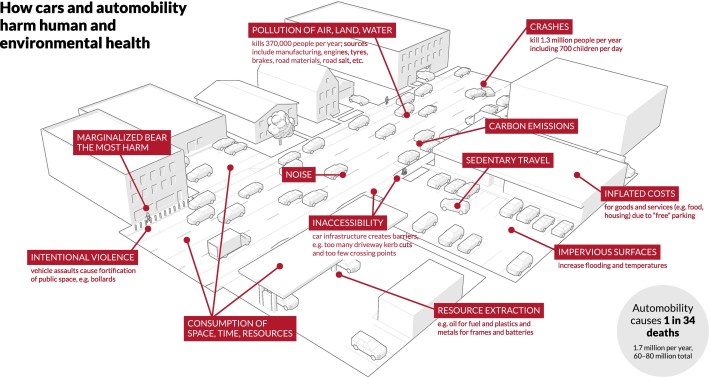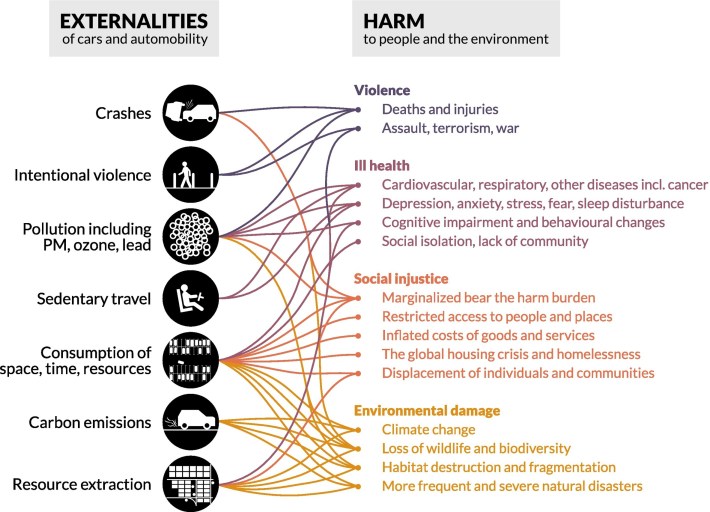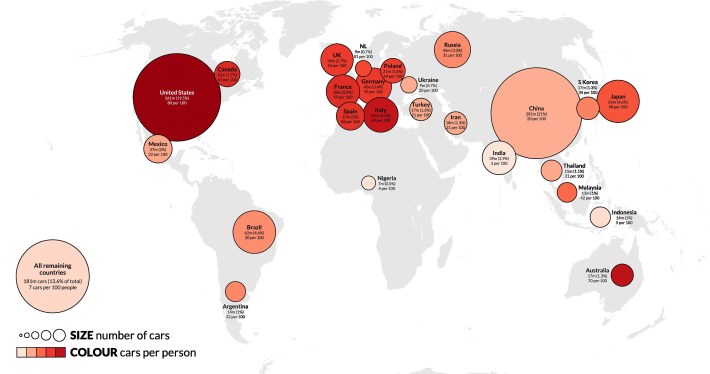Car domination is directly responsible for at least one in every 34 deaths around the world, a new analysis finds — but that’s just the tip of a very large iceberg of the many ways that automobile dependence makes life worse for virtually everyone, even in places with very few cars.
In a staggeringly ambitious new literature review, a team of UK and Germany-based researchers combed through nearly 500 studies from around the world that quantified the many harms of “automobility,” an academic term for the interlocking systems of power and culture that conspire to make cars our primary mode of transportation.

What they found was overwhelming — and, by the researchers’ own admission, a significant undercount. Just taking into account car crashes and fatalities linked directly to car-related air pollution and lead exposure, automobility kills at least 1.67 million people around the world every year — a total of 60 to 80 million since the advent of the automobile.
But even topline numbers that scary don’t capture all the ways that car dependency is harmful. And the devastation of putting the motor vehicle at the center of global life will continue to accrue until we trade automobility for a more human-centered transportation system where the car is an option rather than a default.
“While some people benefit from automobility, nearly everyone — whether or not they drive — is harmed by it,” the authors wrote. “Slowing automobility’s violence and pollution will be impossible without the replacement of policies that encourage car harm with policies that reduce it.”
While car dominance has undermined lives around the globe countless ways, here are four primary categories to get you started.

1. Violence
A constant parade of car crash deaths, of course, is the most glaringly obvious downside of our auto-centric system — even if too many people shrug at the fact that humanity has lost more lives to them than they did in both World Wars combined, and that 700 children die on global roads every single day. The study authors point out, though, that car crash injuries deserve far more air time, too, especially considering that up to one in four people alive today have been injured, in many cases, receiving wounds that are “permanently life altering.”
Beyond those statistics on so-called “accidental” crashes, though, are the many ways that cars make intentional acts of violence easier to commit and more deadly, including vehicle–ramming attacks and car bombs. The researchers also highlighted the thousands of global deaths a year in suicides involving car crashes or carbon monoxide from vehicles, murders and injuries sustained during drive-by shootings, as well as pretextual police violence in traffic settings, which primarily impact BIPOC and low-income people. They even flagged automobility’s deep connections to deaths in oil-related conflicts, which one study they reviewed estimated to be responsible for up to 50 percent off interstate wars since 1973; wars for other car components, like precious metals and battery materials, were flagged, too.
2. Ill health
It’s no secret that a lot of global air pollution is coming out of drivers’ collective tailpipes, or that particle pollution from the breakdown of tires, brakes and even the surface of the road itself can each take a toll on our health. Even the researchers were astonished, though, by the sheer scale of health problems that car emissions can cause, including neurological conditions, premature births, heart and lung diseases, and even leukemia — or that these deadly pollution-related health conditions, collectively, add up to 246,000 global fatalities a year.
Some of the most overlooked diseases, the researchers say, have to do with car-related lead exposure, which persists on our roads despite widespread bans on leaded gasolines. That’s because the deadly substance still shows up in car paints, batteries, and the paint we use to make road markings, and because “moving vehicles cause lead-contaminated soils and road dusts to be re-suspended in the air which people then inhale” even years after the lead was first deposited on the ground. Put it all together, and some research suggests that automobility alone causes120,000 lead exposure deaths annually.
And then there are the health conditions that the researchers couldn’t include in their “1 in 34” the death toll, such as vehicular noise pollution — which one study traced to 10,100 premature deaths a year in 32 European countries, but whose impact hasn’t been comprehensively studied in the U.S. and other countries. There’s also excess light pollution on sprawling streets and parking lots and from headlights themselves – one of several reason why automobility disrupts our sleep pattern — and thermal pollution from over-paved cities that can cause heat stroke or worsen other health conditions as asphalt soaks up rising temperatures. A mountain of research shows that sedentary lifestyle diseases are also exacerbated by car-dependence, though researchers are just beginning to wrap their heads around how to isolate the role of automobility in discouraging people from getting even the most basic exercise.
And finally, there’s the colossal and largely under-discussed mental health impacts of car dependency, including social isolation, depression, and the loss of independence, play, and spatial reasoning for children. And don’t underestimate the simple anxiety of turning every attempt to simply cross the street into “a life-and-death decision process.”
And despite public perception, car dependency is proven to make it harder to access health care to get basic treatment for any of these problems — and heavy traffic even suppresses ambulance response times when you need life-saving care.
3. Social Injustice
From car crashes to pollution, virtually every item on this list disproportionately impacts socially and racially marginalized people — not least people who don’t drive, which the study authors point out constitutes “most people on the planet.”

Some “car harms,” though, confer injustices all their own, like the disproportionate threat of pollution, traffic violence, and police violence for people of color, and the use of forced indigenous labor in road and auto building, particularly in colonized nations.
People from marginalized genders also face unique harms under automobility, like higher rates of crash injuries and deaths among women and people assigned female at birth because crash test dummies aren’t designed with non-male bodies in mind. That may help explain the horrifying fact that car crashes are the leading cause of injuries for pregnant women.
Of course, many people with disabilities rely on cars to get around. But the study authors argue that few are well-served by car dependency, which creates inaccessible communities for people who benefit from having mobility options that suit a wide range of needs. That’s particularly true for people with disabilities who can’t drive, like those with certain visual and cognitive impairments; it’s also true for the many folks who can’t afford an accessible car, or who simply struggle to get from the wheelchair-inaccessible bus stop to the grocery store across the six-lane stroad.
The researchers also point out that, in a sense, “car-dependent environments ‘disable’ people who do not drive by restricting access to essential needs” and basic wants, especially if they are very poor, very young or very old. That’s in part because of the sheer amount of space, time and resources cars consume that could be devoted to other uses, which can increase housing costs by dedicating scarce land to free or cheap parking instead, starve and slow down transit and other modes to build senseless highway expansions, or monopolize government resources and attention to coordinate massive, overbuilt road networks, even as other dire societal problems go unsolved.
And needless to say, automobility cannabilizes our individual resources, too, whether that’s car-related payments we can’t afford, time lost in traffic, or all the money we pay to subsidize driving, whether or not we ever get behind the wheel ourselves.
4. Environmental Damage
Climate change aside, mass car use has caused a raft of other environmental harms that can’t possibly be surveyed in a single paper. Still, it’s worth noting that virtually every stage of the “motor vehicle life cycle” involves devastation for the environment, from the massive and unsustainable resource extraction required to build and fuel the least resource-efficient mode around, to the massive amounts of trash sent to the landfill or the incinerator when each car reaches the end of its life and roughly two-thirds of its components aren’t recycled.
Automobility also requires vast environmental damage beyond the windshield, including sprawling, parking-rich development patterns that annihilate natural habitats and force other industries to pollute even more to bring goods, services, and utilities to all those spread-out people. Along the way, cars have become a primary source of microplastic pollution, as well as a primary driver of toxic runoff that shunts polluted rainwaters from over-paved cities into delicate ecosystems, where they wreak havoc on natural life. One study found that “in an Arctic ice core with a bottom dating back to c. 1966, tire particles constituted 24 percent of observed plastic particles,” just in case you’re a screenwriter looking for a plot for your next dystopian sci-fi movie.
And that’s before we even talk about oil spills, road salt pollution, how all these forms of pollution and traffic violence impacts wildlife and the ecosystems they’re a part of, and so much more.
… and that’s not all.
Of course, a skeptic might look at this list and ask whether the benefits of automobility somehow outweigh its many costs. Study author Patrick Miner said, though, that doing that accounting essentially allows car culture to set the terms of the debate, forcing us to assign monetary value to the lives and life experiences that automobility steals from us and then weigh them against the value of the supposed benefits that car culture abritrarily assigns to itself.
“One of the downsides to cost/benefit analysis is that … if something can’t be quantified, or something can’t be compared to a monetary value, then it can’t be counted,” he says. “So, for example, if automobility has contributed, you know, X billion dollars of economic growth ... how do we compare that to killing 60 to 80 million people?”
Moreover, Miner acknowledges that the full toll that car culture takes is likely uncountable. His study, for instance, couldn’t get into how cars facilitate mass surveillance of their passengers and everyone with whom they share the road, or how they make cities less beautiful, or the universe of other “car harms” that advocates and researchers are continuing to identify every day. And the researchers also didn’t have time to quantify exactly how much our communities would benefit if we embraced a more human-centered system — though that’s certainly no excuse not to do it.
“There are so many different things that we can do to make our cities healthier, and more sustainable and happier places to live,” added Miner. “And a lot of those things involve creating more space and safety for walking, cycling, wheeling, and public transport. So whether that’s creating new car-light areas in cities, or even just reducing traffic speeds — all of these things can help.”
Editor's note: a quote in this article has been amended slightly at the request of the speaker.






